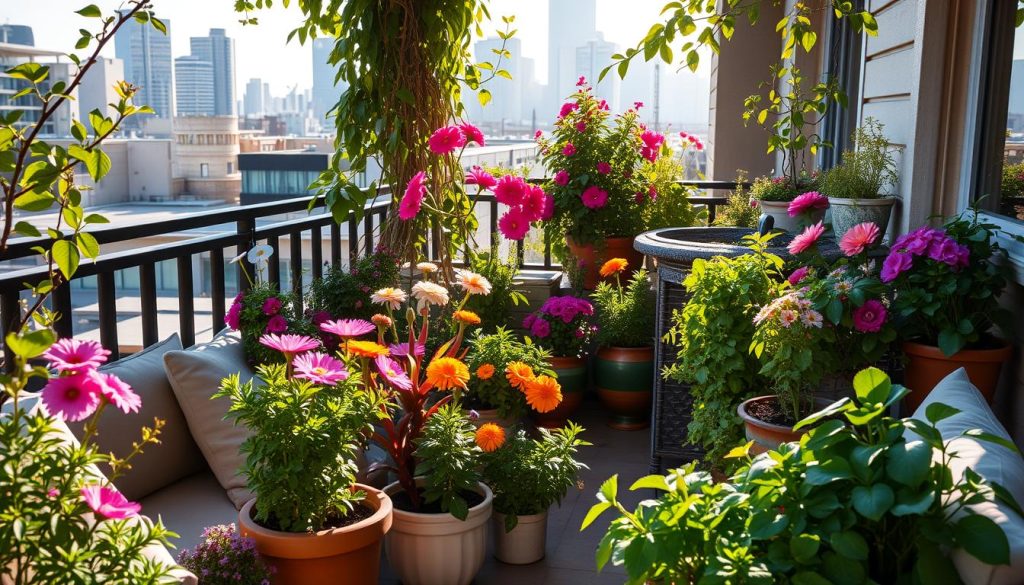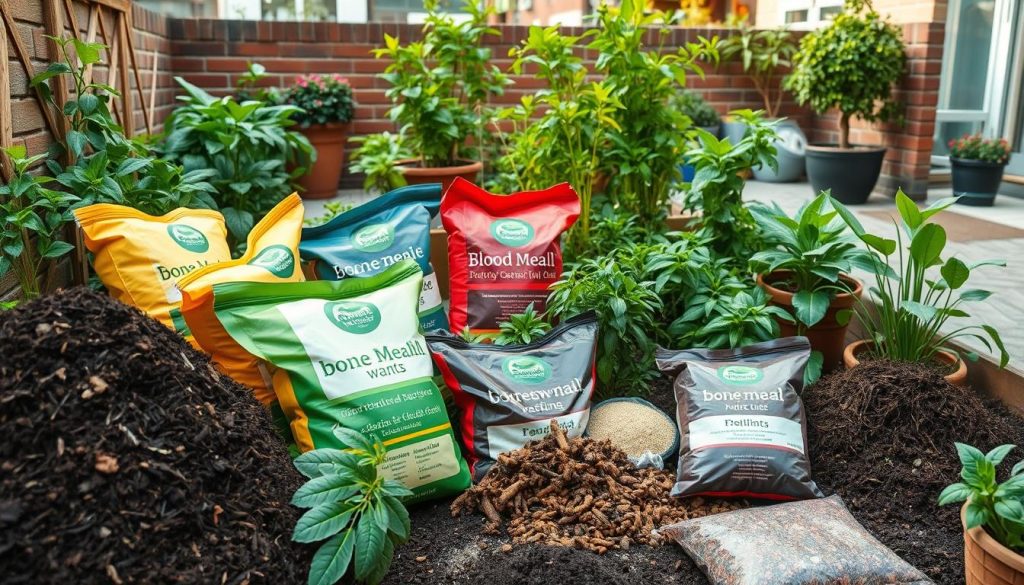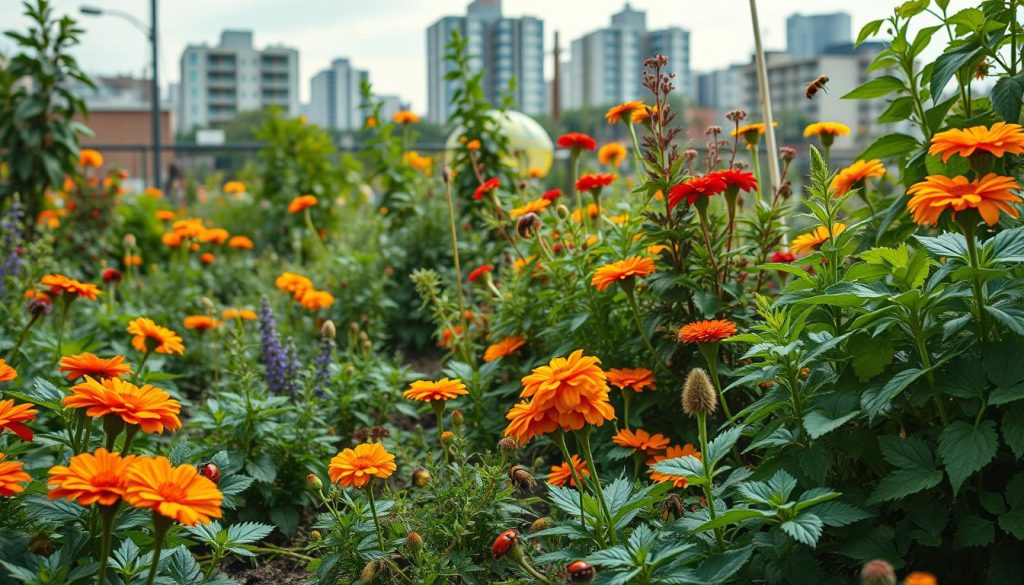I’ve always loved bringing nature into the city. Urban gardening lets city folks like me create green spaces in unexpected places. With the right tips, anyone can turn a small spot into a lush oasis.
Small-space gardening is more than just making our cities look nice. It’s about growing our own food, cutting down on carbon, and connecting with nature. Whether you’re experienced or just starting, urban gardening offers endless possibilities.
In this guide, I’ll share my top urban gardening tips. We’ll cover how to use every inch of space and pick the best plants. Let’s get started and enjoy the beauty of city gardening!
Getting Started with Urban Gardening
Urban gardening brings nature to city life. Container and small-space gardening are great for cities. Let’s dive into starting your city garden.
Assessing Your Available Space
First, I check my space. Balconies, windowsills, and fire escapes can be green spots. I measure and note sunlight to plan my garden.
Choosing the Right Plants for Your Urban Environment
City gardens face special challenges. I choose plants that do well in containers and urban conditions. Herbs, leafy greens, and compact veggies are perfect for small spaces. Here are my favorites:
- Tomatoes (cherry varieties)
- Basil
- Lettuce
- Peppers
- Mint
Essential Tools for City Gardeners
The right tools make gardening easier. I keep my toolkit simple:
| Tool | Use |
|---|---|
| Hand trowel | Planting and transplanting |
| Pruning shears | Trimming and harvesting |
| Watering can | Controlled watering |
| Gloves | Hand protection |
With these basics, I’m set to start my urban garden. Container gardening lets me grow fresh produce and plants in the city.
Container Gardening: Maximize Your Small Space
I love container gardening! It’s perfect for small spaces in cities. With a few pots and some creativity, you can turn any small balcony or patio into a lush oasis.
Choosing the right containers is key. I like large, deep pots for most plants. They hold more soil, which means better root growth and less watering. For herbs and small flowers, window boxes are great.
Soil mix is crucial. I mix potting soil, compost, and perlite. This mix ensures good drainage and keeps nutrients. Remember, plants in containers need more food than those in the ground.
Choosing plants is fun but tricky in small spaces. I pick compact varieties and plants that do double duty. Here are my top picks for container gardens:
- Cherry tomatoes
- Dwarf citrus trees
- Herbs like basil and mint
- Compact peppers
- Trailing flowers for color
Where you place your containers matters a lot. I arrange them to get the most sunlight and look good. Taller plants go in the back, and shorter ones in front. This makes my small space look bigger and greener.
| Container Type | Best For | Pros | Cons |
|---|---|---|---|
| Terracotta Pots | Herbs, Succulents | Breathable, Natural Look | Heavy, Can Dry Out Quickly |
| Plastic Containers | Vegetables, Annuals | Lightweight, Affordable | Less Durable, Can Look Cheap |
| Wooden Planters | Perennials, Shrubs | Attractive, Insulating | Can Rot Over Time |
| Hanging Baskets | Trailing Plants, Flowers | Space-Saving, Decorative | Need Frequent Watering |
Vertical Gardening: Growing Up Instead of Out
Vertical gardening is a big help for city folks with little space. It lets me grow many plants without using up floor space. Let’s see how you can make your own vertical garden paradise.
DIY Vertical Garden Structures
Making your own vertical garden is simpler than you think. I’ve used old pallets, hanging shoe organizers, and gutters. These DIY projects save money and make your space special. Start by attaching small pots to a trellis or fence with strong hooks.
Best Plants for Vertical Gardens
Not all plants do well in vertical gardens. Here are some that really thrive:
- Herbs: Basil, thyme, and mint
- Vegetables: Cherry tomatoes, peppers, and lettuce
- Flowers: Petunias, pansies, and succulents
These plants are light, small, and don’t need deep soil. They’re ideal for vertical gardens.
Maintenance Tips for Vertical Gardens
Keeping your vertical garden healthy needs some tips. I water my plants more often because they dry out quicker. A slow-release fertilizer gives them the nutrients they need. Regular pruning keeps them small and in check. With these tips, your vertical garden will bloom, turning your city space into a green oasis.
Balcony Gardening: Creating a Green Oasis

I love turning small urban spaces into lush green havens. Balcony gardening brings nature right to your doorstep, even in the city. With creativity and the right approach, you can make your balcony a thriving garden oasis.
When starting your balcony garden, think about the unique challenges of your space. Wind and sunlight patterns are key in choosing plants. I’ve found that hardy, compact plants do well in these conditions. Container gardening is essential for balconies, making it easy to arrange and maintain.
Here’s a list of plants that work well for balcony gardens:
- Herbs: Basil, mint, and rosemary
- Vegetables: Cherry tomatoes and compact peppers
- Flowers: Petunias, marigolds, and geraniums
- Succulents: For low-maintenance options
To make the most of your balcony, think vertically. Use hanging baskets, wall-mounted planters, and tiered shelves to increase your growing space. This not only adds beauty but also makes your garden more immersive.
| Balcony Type | Recommended Plants | Container Types |
|---|---|---|
| Sunny | Tomatoes, Peppers, Marigolds | Terra cotta pots, Raised beds |
| Shaded | Ferns, Hostas, Impatiens | Hanging baskets, Window boxes |
| Windy | Ornamental grasses, Lavender | Heavy ceramic pots, Wall planters |
Successful balcony gardening is about finding harmony between plants, containers, and your living space. Follow these tips to enjoy your own green oasis in the sky.
Urban Gardening Tips for Beginners
Starting your urban gardening journey can feel overwhelming, but I’m here to help! With these tips, you’ll be growing your own organic garden in no time. Let’s dive into the basics to get you started on the right foot.
First, let’s talk soil. Good soil is the foundation of any successful garden. For container gardens, I recommend using a high-quality potting mix. This ensures proper drainage and provides essential nutrients for your plants. If you’re working with existing soil, consider getting it tested for contaminants – a common issue in urban areas.
Watering is crucial in urban gardening. I’ve found that using a moisture meter helps prevent overwatering, which is a common mistake among beginners. For smaller plants, bottom watering can be effective. Simply place your pots in a tray of water and let them soak up what they need.
Choosing the right plants is key to success. Here’s a list of some easy-to-grow plants perfect for urban gardening beginners:
- Herbs: Basil, mint, cilantro
- Vegetables: Cherry tomatoes, lettuce, peppers
- Flowers: Marigolds, petunias, sunflowers
Remember, organic gardening practices are not only better for the environment but also for your health. Avoid chemical pesticides and fertilizers. Instead, try companion planting or natural pest deterrents like neem oil.
| Urban Gardening Challenge | Solution |
|---|---|
| Limited space | Use vertical gardening techniques |
| Poor soil quality | Use raised beds or containers with quality potting mix |
| Lack of sunlight | Choose shade-tolerant plants or use grow lights |
| Pest problems | Implement companion planting and natural pest control methods |
With these urban gardening tips, you’re well on your way to creating a thriving garden in your city space. Remember, gardening is a learning process, so don’t be discouraged if things don’t go perfectly at first. Keep experimenting and enjoy watching your urban oasis grow!
Soil Health in the City: Composting and Fertilizing

In cities, keeping soil healthy is key for organic gardening success. I’ve learned that composting and fertilizing right can turn tough city spots into lush gardens.
Urban Composting Methods
You can compost in the city. I use a small composter on my balcony for kitchen scraps. It makes rich soil for my plants. For tiny spaces, vermicomposting with worms works great, even under the kitchen sink.
Organic Fertilizers for Container Plants
For container gardening, I choose organic fertilizers. Compost tea is a strong liquid fertilizer. I also use fish emulsion and seaweed extract for nutrients without harmful chemicals.
Dealing with Urban Soil Contamination
City soil often has pollutants from factories. To garden safely, I test my soil first. If it’s contaminated, I use raised beds or containers. I’m also looking into using plants to clean the soil.
| Composting Method | Space Required | Ideal For |
|---|---|---|
| Tumbler Composter | Small | Balconies, Small Yards |
| Vermicomposting | Very Small | Indoor Spaces |
| Bokashi | Small | Kitchens, Small Apartments |
Water Conservation Techniques for City Gardens
Water conservation is crucial in urban gardening. City gardens face unique challenges. But, with the right tips, you can create a thriving oasis while being eco-friendly. Let’s explore some water-saving techniques for container gardening and more.
Efficient watering methods are essential. I use a drip irrigation system for my containers. It delivers water directly to the roots, reducing evaporation. For smaller setups, self-watering containers are a game-changer. They store water for plants to drink as needed.
Choosing drought-resistant plants is smart. Succulents, lavender, and native species need less water. I’ve had great success with these in my container gardening. They’re not only water-wise but also add variety to my garden.
Rainwater harvesting is a great way to reduce water usage. I installed a simple rain barrel system to collect roof runoff. It’s surprising how much water you can save! This free resource is perfect for watering plants during dry spells.
Mulching is a simple yet effective tip. A layer of organic mulch around plants helps retain moisture and suppress weeds. I use wood chips or straw, which slowly break down and enrich the soil.
By using these water conservation techniques, you’ll save on your water bill. You’ll also contribute to a more sustainable urban environment. Happy gardening!
Pest Management in Urban Gardens

Urban gardening tips often miss pest management, but it’s key for a thriving garden. Organic gardening can control pests without harmful chemicals. Let’s look at eco-friendly ways to keep your urban garden healthy and productive.
Common Urban Garden Pests
City gardens often face aphids, slugs, and spider mites. These pests can harm your plants if not stopped. Spotting them early is crucial for a healthy garden.
Natural Pest Control Methods
Natural pest control works well in my urban garden. Neem oil spray fights aphids, and diatomaceous earth stops slugs. For spider mites, misting plants with water helps keep them away.
| Pest | Natural Control Method |
|---|---|
| Aphids | Neem oil spray |
| Slugs | Diatomaceous earth |
| Spider Mites | Regular misting |
Companion Planting for Pest Prevention
Companion planting is a smart way to keep pests away. Marigolds near vegetables repel aphids, and basil keeps flies and mosquitoes off. It also boosts biodiversity in my garden.
Using these tips and organic pest control, my city garden thrives. A healthy garden is the best defense against pests!
Edible Landscaping: Combining Beauty and Function
I’m excited to share some urban gardening tips about edible landscaping. This approach turns your outdoor space into a beautiful and productive garden. By mixing ornamental plants with fruits, vegetables, and herbs, you create a stunning landscape that’s also a source of fresh food.
Fruit trees make excellent focal points. A dwarf apple or pear tree can serve as a centerpiece, providing shade and tasty fruits. Surrounding it with colorful leafy greens like rainbow chard or red-veined sorrel adds visual interest and nutritional value to your garden.
Herbs are perfect for edible landscaping. I love using rosemary as a low hedge, while thyme makes a fragrant ground cover. Lavender adds both color and aroma, plus its flowers are edible. These plants not only look great but also attract beneficial insects to your garden.
Here’s a quick guide to some edible plants that double as ornamentals:
| Plant | Ornamental Use | Edible Part |
|---|---|---|
| Swiss Chard | Colorful foliage | Leaves |
| Nasturtium | Bright flowers | Flowers, leaves |
| Blueberry | Shrub with fall color | Berries |
| Chives | Grass-like texture | Leaves, flowers |
Remember, successful edible landscaping requires planning. Consider each plant’s sunlight and water needs when designing your layout. With these urban gardening tips, you’ll create a beautiful, functional space that nourishes both body and soul.
Community Gardens: Joining Forces with Fellow Urban Gardeners
Urban gardening tips often lead us to community gardens. These shared spaces bring people together to grow food and flowers. I’ve found that joining a community garden is a great way to meet neighbors and learn new skills.
Finding Community Gardens Near You
To find a community garden in your area, check with your local parks department or search online directories. Many cities have networks of community gardens spread across neighborhoods. I discovered my local garden through a flyer at the library.
Benefits of Joining a Community Garden
Being part of a community garden offers many perks. You’ll share tools, knowledge, and sometimes even harvests. It’s a chance to swap urban gardening tips with others. I’ve learned so much about composting and pest control from my fellow gardeners.
Starting Your Own Community Garden Project
If you can’t find a garden nearby, why not start one? Begin by gathering interested neighbors and scouting potential locations. Contact your city officials to learn about land use rules. Starting a community garden takes work, but it’s rewarding. I’ve seen firsthand how it can transform empty lots into vibrant green spaces.

